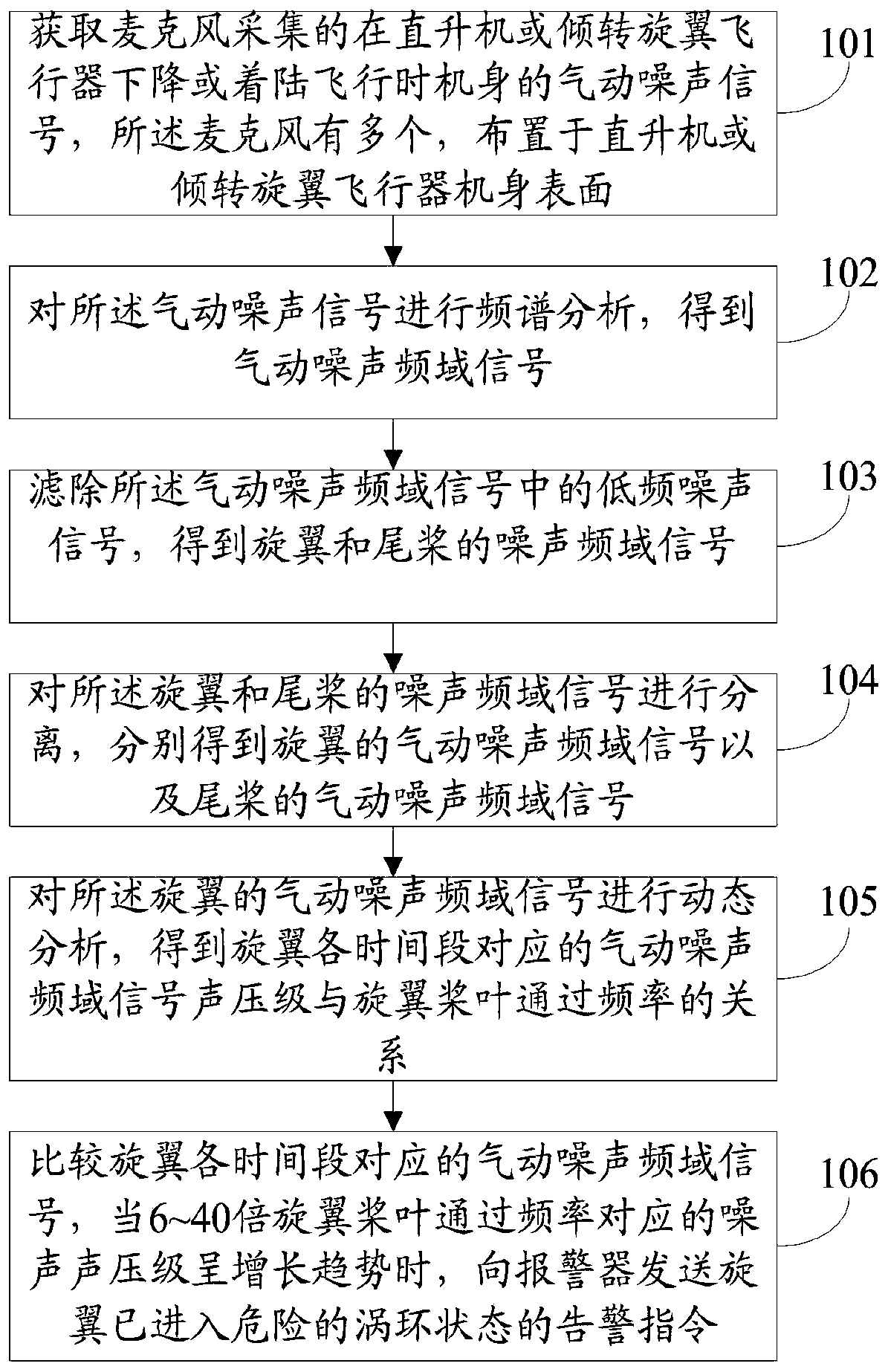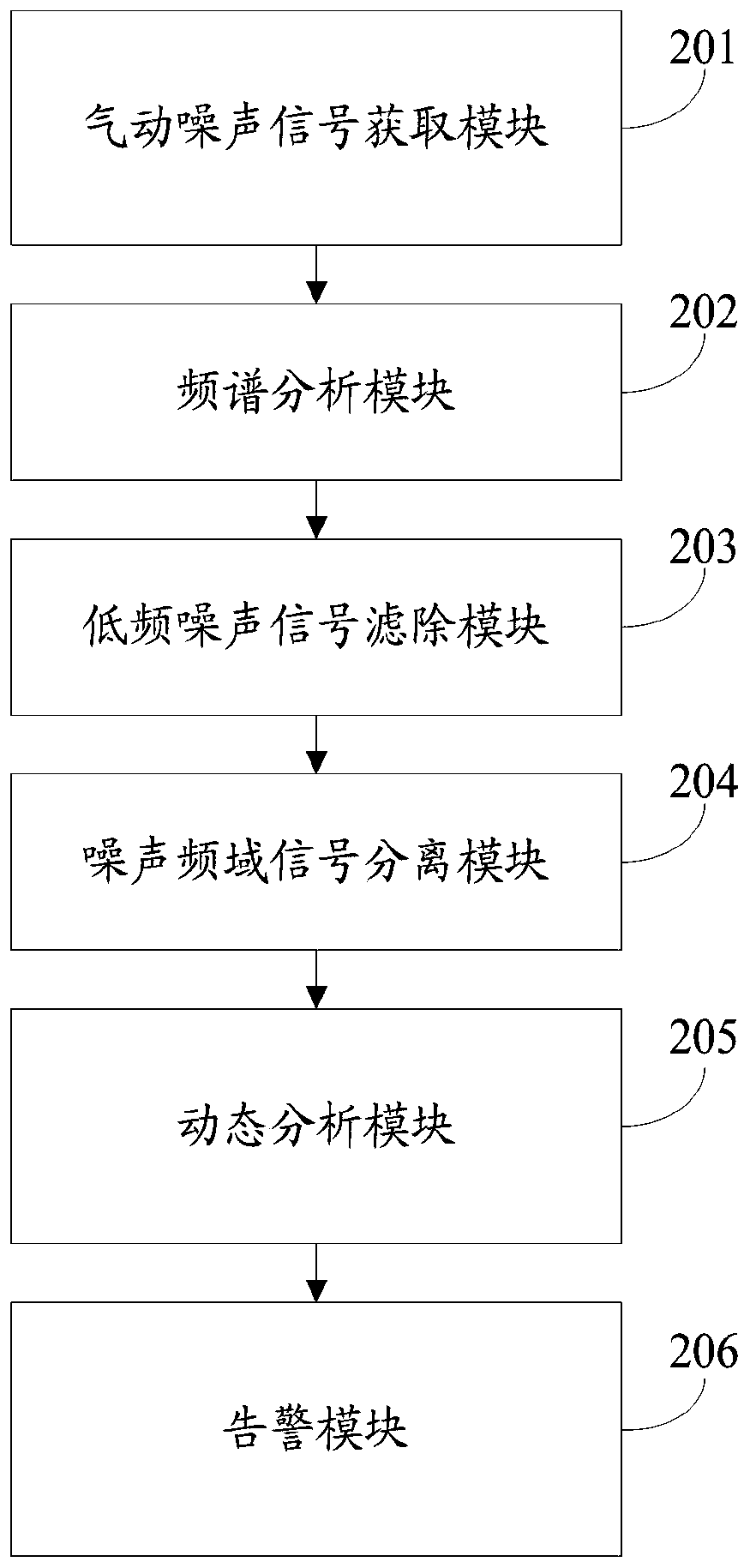Automatic warning system and method of rotor vortex ring status based on aerodynamic noise monitoring
An aerodynamic noise and automatic early warning technology, applied in the field of rotorcraft, can solve problems such as the difficulty of direct monitoring of rotor tension and torque, the rotor being trapped in a deep vortex ring state, and affecting the performance of the rotor. It achieves convenient implementation, simple structure, and convenient signal acquisition. Effect
- Summary
- Abstract
- Description
- Claims
- Application Information
AI Technical Summary
Problems solved by technology
Method used
Image
Examples
Embodiment 1
[0047] figure 1 It is a schematic flowchart of the automatic early warning method for rotor vortex ring status based on aerodynamic noise monitoring in the present invention.
[0048] Such as figure 1 As shown, the automatic warning method of rotor vortex ring status based on aerodynamic noise monitoring includes:
[0049] Step 101: Obtain the aerodynamic noise signal of the fuselage collected by the microphone when the helicopter or tilt-rotor aircraft descends or lands, such as image 3 As shown, there are multiple microphones arranged on the surface of the fuselage of a helicopter or a tilt-rotor aircraft;
[0050] Step 102: performing frequency spectrum analysis on the aerodynamic noise signal to obtain an aerodynamic noise frequency domain signal;
[0051] Step 103: Filter out the low-frequency noise signal in the aerodynamic noise frequency-domain signal to obtain the noise frequency-domain signal of the rotor and tail rotor;
[0052]Step 104: Separate the noise freq...
Embodiment 2
[0061] figure 2 It is a structural schematic diagram of the automatic warning system of the rotor vortex ring state based on the aerodynamic noise monitoring of the present invention.
[0062] Such as figure 2 As shown, the automatic warning system of rotor vortex ring status based on aerodynamic noise monitoring includes:
[0063] The aerodynamic noise signal acquisition module 201 is used to acquire the aerodynamic noise signal of the fuselage collected by the microphone when the helicopter or the tilt-rotor aircraft descends or lands, and there are multiple microphones arranged on the surface of the fuselage of the helicopter or the tilt-rotor aircraft ;
[0064] A spectrum analysis module 202, configured to perform spectrum analysis on the aerodynamic noise signal to obtain an aerodynamic noise frequency domain signal;
[0065] The low-frequency noise signal filtering module 203 is used to filter out the low-frequency noise signal in the aerodynamic noise frequency-do...
Embodiment 3
[0078] Taking a single-rotor helicopter with a tail rotor as an example, the number of rotor and tail rotor blades is two, the passing frequency of the rotor blade is 13Hz, and the passing frequency of the tail rotor is 55Hz. The automatic warning of the rotor vortex ring status based on aerodynamic noise monitoring Methods include:
[0079] Acquisition of aerodynamic noise signal: Acquire the aerodynamic noise signal of the fuselage collected by the microphone when the helicopter or tilt-rotor aircraft descends or lands, such as image 3 As shown, there are multiple microphones, which are arranged on the surface of the fuselage of a helicopter or a tilt-rotor aircraft. When doing other flights such as level flight, the microphones are kept closed to improve their service life.
[0080] Aerodynamic noise signal spectrum analysis: Divide the time-domain dynamic noise signal of each microphone into several segments. For example, assuming that the current noise signal has been co...
PUM
 Login to View More
Login to View More Abstract
Description
Claims
Application Information
 Login to View More
Login to View More - R&D
- Intellectual Property
- Life Sciences
- Materials
- Tech Scout
- Unparalleled Data Quality
- Higher Quality Content
- 60% Fewer Hallucinations
Browse by: Latest US Patents, China's latest patents, Technical Efficacy Thesaurus, Application Domain, Technology Topic, Popular Technical Reports.
© 2025 PatSnap. All rights reserved.Legal|Privacy policy|Modern Slavery Act Transparency Statement|Sitemap|About US| Contact US: help@patsnap.com



